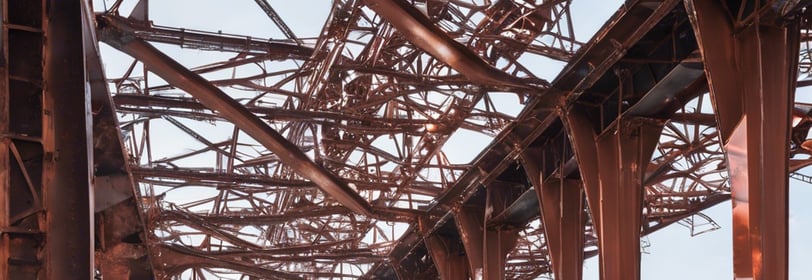IS 1517:2015 - Guide to Selecting Painting Systems for Steel Structures


Introduction to IS 1517:1970
IS 1517: 1970 – Guide for the Selection of Painting Systems for Various Types of Steel Structures provides comprehensive guidelines to ensure effective corrosion protection of steel structures. Below are more detailed insights into the standard:
Introduction
Steel structures are widely used in various industries, including construction, transportation, and manufacturing, due to their strength and durability. However, steel is prone to corrosion when exposed to different environmental conditions. IS 1517 provides systematic guidelines for choosing appropriate painting systems to protect steel structures from such degradation.
Corrosion Mechanisms
Corrosion is an electrochemical process where steel reacts with oxygen and moisture to form rust, leading to the deterioration of the structure. The standard identifies key factors that influence the rate of corrosion:
Atmospheric conditions: Humidity, temperature, and pollution levels.
Marine environments: Exposure to saltwater accelerates corrosion.
Chemical exposure: Acidic or alkaline environments.
Industrial exposure: Pollutants, such as sulfur compounds, that react with steel.
Surface Preparation
The performance of any protective painting system largely depends on how well the steel surface is prepared before the paint is applied. IS 1517 emphasizes:
Degreasing: Removing oil, grease, and dirt.
Rust removal: Mechanical cleaning (wire brushing, abrasive blasting), chemical cleaning (acid pickling), or flame cleaning to remove mill scale, rust, and old paint.
Surface roughness: Achieving the right surface profile is crucial to ensure the paint adheres properly. Abrasive blasting (sandblasting or shot blasting) is often recommended.
Grades of Surface Preparation (as per the standard):
St 2: Hand or power tool cleaning.
St 3: Thorough cleaning using power tools.
Sa 2 ½: Near-white blast cleaning, often recommended for severe environments.
Selection of Painting Systems
The standard provides a detailed guide for selecting suitable painting systems based on the environmental conditions to which the steel structure will be exposed:
Primer Coatings: Primers are essential for adhesion and provide the first line of defense against corrosion. Commonly used primers include:
Zinc-rich primers: Sacrificial coatings that corrode in place of steel, providing cathodic protection.
Red oxide primers: Provide basic protection against rust.
Epoxy primers: Offer good adhesion and chemical resistance.
Intermediate Coatings:
These coatings are used to build up the film thickness and enhance the protective properties. The intermediate coat often contains micaceous iron oxide (MIO), which increases the barrier effect and prevents moisture ingress.
Top Coats:
The top coat serves as the final protective layer and is exposed to the environment. Common types include:
Alkyd paints: Suitable for moderate environments.
Chlorinated rubber paints: Used for areas exposed to harsh chemicals.
Polyurethane paints: Known for their UV resistance and gloss retention, making them ideal for outdoor structures.
Epoxy paints: Provide excellent resistance to chemicals and moisture.
Environmental Classification
The standard divides environmental conditions into categories to tailor the painting system to specific requirements:
Mild Environment (e.g., rural areas): Moderate levels of humidity, low pollution.
Industrial Environment: High pollution, acidic gases such as sulfur dioxide.
Marine Environment: Coastal and offshore areas exposed to saltwater, requiring highly resistant coatings.
Submerged Environment: Structures submerged in water, such as pipelines, jetties, and piers, where coatings must prevent corrosion in high-moisture environments.
High-Temperature Environments: Structures exposed to elevated temperatures require specialized high-heat-resistant paints.
Coating Thickness and Durability
The performance and longevity of painting systems are closely related to the thickness of the coatings applied. IS 1517 provides guidance on minimum dry film thickness (DFT) for each coating layer. For example:
Primer: 25-75 microns.
Intermediate coat: 50-100 microns.
Top coat: 25-50 microns.
Maintenance and Inspection
Regular maintenance of painted steel structures is essential for extending their lifespan. The standard emphasizes:
Periodic inspection: Checking for signs of rust, blistering, or cracking.
Touch-up painting: When minor damage occurs, the affected areas should be cleaned and repainted to prevent further corrosion.
Full repainting: In extreme cases of deterioration, a complete repainting may be necessary.
Recommendations for Specific Applications
Bridges: Require heavy-duty painting systems due to exposure to high levels of humidity, varying temperatures, and pollutants.
Transmission Towers: Need systems that are resistant to atmospheric corrosion.
Marine Structures: Require highly durable coatings resistant to salt spray and immersion in water.
Chemical Plants: Must have coatings that resist chemical attacks and provide high durability in aggressive environments.
Testing and Quality Control
The standard recommends tests to ensure the integrity and performance of the applied painting systems, such as:
Adhesion tests: Ensures that the paint adheres well to the steel substrate.
Salt spray tests: Simulate long-term exposure to saltwater for marine environments.
Impact resistance: To ensure that the coating can withstand mechanical stress.
Conclusion:
IS 1517 serves as a critical guideline in selecting painting systems for various steel structures. By recommending different coatings, surface preparation techniques, and tailored solutions for specific environmental conditions, the standard ensures long-term protection of steel assets against corrosion, leading to enhanced durability and reduced maintenance costs.
